Composting at home is an excellent way to reduce waste and create nutrient-rich soil for your garden. If you’re new to composting, the process may seem a bit overwhelming, but with a few basic tips and some patience, anyone can start composting successfully. This guide offers beginner-friendly advice to help you get started on your composting journey.
What is Composting?
Composting is the natural process of recycling organic materials, such as food scraps and yard waste, into a valuable soil amendment known as compost. This process enriches garden soil, improves soil structure, and helps plants retain moisture. Composting is not only good for gardens but also reduces the amount of waste sent to landfills.
Why Compost at Home?
– Reduce landfill waste: Composting diverts food scraps and garden debris from the trash.
– Create nutrient-rich soil: Compost helps your plants grow healthy and strong.
– Save money: Reduce the need to buy commercial fertilizers.
– Promote sustainability: Composting supports eco-friendly living by recycling organic matter.
Getting Started: Basic Composting Materials
What Can You Compost?
Understanding what to include in your compost bin is essential. Materials are generally categorized as “greens” and “browns.”
– Greens (Nitrogen-rich materials):
– Fruit and vegetable scraps
– Coffee grounds and tea bags
– Fresh grass clippings
– Plant trimmings
– Browns (Carbon-rich materials):
– Dry leaves
– Straw or hay
– Shredded newspaper or cardboard
– Wood chips
What Not to Compost
Avoid putting the following items in your compost to prevent odors, pests, or slow decomposition:
– Meat, fish, and dairy products
– Oils and fats
– Pet waste
– Diseased plants
– Synthetic chemicals or treated wood
Choosing a Compost Bin or Pile
Depending on your space and preferences, you can choose from several options:
– Compost Bin: A closed container that helps retain heat and moisture, suitable for small spaces.
– Compost Tumbler: A rotating bin that makes mixing easy and speeds up decomposition.
– Compost Pile: Simply a pile in your backyard, ideal if you have plenty of space.
Make sure your compost bin or pile is placed in a well-drained area with some sunlight to encourage microbial activity.
Step-by-Step Composting Process
1. Set Up Your Compost Area
Choose a convenient spot near your garden or kitchen. If using a bin, assemble it according to instructions and place it on bare soil if possible. This allows beneficial organisms to enter the compost.
2. Start Adding Materials
Begin layering your greens and browns. A good rule of thumb is to use roughly three parts browns to one part greens. This balance keeps the compost healthy and prevents odors.
3. Maintain Moisture
Your compost should be as damp as a wrung-out sponge. Too dry, and decomposition slows down; too wet, and it may become smelly. Water your compost occasionally if it becomes dry.
4. Turn Your Compost
Turning or mixing the pile once every week or two introduces oxygen, which speeds up composting and prevents bad odors. Use a pitchfork or compost aerator for this task.
5. Watch and Wait
Depending on conditions like temperature, moisture, and materials used, composting can take anywhere from a few months to a year. Finished compost will look dark, crumbly, and smell earthy.
Troubleshooting Common Composting Issues
– Bad odor: Usually caused by too much moisture or not enough browns. Add dry leaves or newspaper and turn the pile.
– Pests: Avoid adding meats or oily foods. Cover food scraps with browns and keep your bin closed.
– Slow decomposition: Make sure your compost has the right moisture and turns regularly. Chop materials into smaller pieces to speed up breakdown.
– Compost too dry: Add water and mix to increase moisture.
Tips to Make Composting Easier for Beginners
– Use a kitchen compost bin with a lid to collect scraps and avoid mess.
– Chop or shred materials to help them break down faster.
– Keep a dedicated container for your kitchen scraps that’s easy to carry outdoors.
– Start small and increase your composting volume as you get comfortable.
– Consider using composting worms (vermicomposting) if you have limited space or want faster results.
Using Your Finished Compost
Once your compost looks rich and crumbly, it’s time to use it in your garden:
– Mix it into garden beds to improve soil fertility.
– Use it as mulch around plants to retain moisture.
– Add it to potting mixes for container plants.
– Top-dress your lawn to enrich the soil.
Final Thoughts
Composting at home is a rewarding way to reduce waste and enrich your garden soil naturally. With these beginner tips, you can start composting confidently and enjoy the benefits of healthier plants and a greener lifestyle. Remember that composting is a learning process—don’t be discouraged by initial challenges, and adjust your methods as you gain experience.
Give it a try, and watch your kitchen scraps turn into garden gold!

